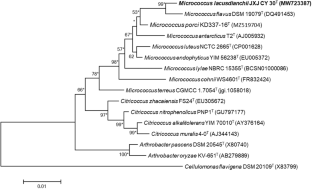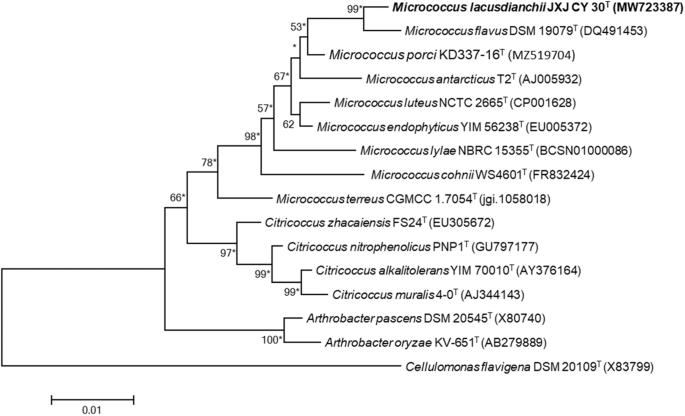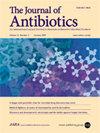被共生藻类代谢物抑制的附着细菌--Micrococcus lacusdianchii sp.
IF 2.1
4区 医学
Q3 BIOTECHNOLOGY & APPLIED MICROBIOLOGY
引用次数: 0
摘要
从中国滇池采集的铜绿微囊藻(Microcystis aeruginosa FACHB-905,Maf)的藻层中分离出一株新型放线菌,命名为 JXJ CY 30 T。该菌株为革兰氏染色阳性、需氧、球形放线菌。它的肽聚糖中含有丙氨酸、谷氨酸、天冬氨酸和赖氨酸,细胞壁糖类中含有甘露糖、核糖和阿拉伯糖,细胞内主要脂肪酸为反式-C15:0 和异式-C15:0:0 作为主要的细胞脂肪酸,MK-7 和 MK-8 作为主要的呼吸醌,磷脂酰甘油、二磷脂酰甘油、磷脂酰肌醇、糖脂和一种不明磷脂作为极性脂质。DNA G + C 含量为 73.08%。其 16 S rRNA 基因序列与黄微球菌 DSM 19079 T 和猪微球菌 KD337-16T 的相似度分别为 99.14% 和 98.75%,与其他微球菌属模式菌株的相似度≤98.41%。在系统发生树上与黄曲霉 DSM 19079 T 形成独立支系。菌株 JXJ CY 30 T 与黄曲霉 DSM 19079 T 和孔菌 KD337-16T 的数字 DNA-DNA 杂交和平均核苷酸同一性值分别为 48.0%和 92.1%、25.5%和 83.2%。上述数据表明,菌株 JXJ CY 30 T 代表了微球菌属的一个新种,该种的命名为 Micrococcus lacusdianchii sp.nov.(模式菌株 JXJ CY 30 T = KCTC 49378 T = CGMCC 1.17508 T)。菌株 JXJ CY 30 T 有可能为 Maf 提供各种营养物质,如可利用的磷和氮、植物激素、各种维生素和类胡萝卜素,以促进其生长,而其共生藻 Maf 的代谢产物则对其有抑制作用。本文章由计算机程序翻译,如有差异,请以英文原文为准。


Micrococcus lacusdianchii sp. nov., an attached bacterium inhibited by metabolites from its symbiotic algae
A novel actinobacterial strain, designated as JXJ CY 30 T, was isolated from the phycosphere of Microcystis aeruginosa FACHB-905 (Maf) collected from Lake Dianchi, China. The strain was a Gram-stain-positive, aerobic and coccus-shaped actinobacterium. It had alanine, glutamic acid, aspartic acid, and lysine in the peptidoglycan, and mannose, ribose and arabinose in its cell wall sugars, anteiso-C15:0 and iso-C15:0 as the main cellular fatty acids, MK-7 and MK-8 as the major respiratory quinones, and phosphatidylglycerol, diphosphatidylglycerol, phosphatidylinositol, glycolipid, and an unidentified phospholipid as the polar lipids. The DNA G + C content was 73.08%. Its 16 S rRNA gene sequence shared 99.14%, and 98.75% similarities with Micrococcus flavus DSM 19079 T and M. porci KD337-16T, respectively, and ≤98.41% similarities with other type strains of the genus Micrococcus. It formed independent clade with M. flavus DSM 19079 T on the phylogenetic trees. The digital DNA-DNA hybridization and average nucleotide identity values between strain JXJ CY 30 T and M. flavus DSM 19079 T and M. porci KD337-16T were 48.0% and 92.1%, 25.5% and 83.2%, respectively. These data above indicated that strain JXJ CY 30 T represented a new species of the genus Micrococcus, and the species epithet is proposed as Micrococcus lacusdianchii sp. nov. (type strain JXJ CY 30 T = KCTC 49378 T = CGMCC 1.17508 T). Strain JXJ CY 30 T can potentially provide Maf with various nutrients such as available phosphorus and nitrogen, plant hormones, various vitamins and carotenoids for growth, while it was inhibited by metabolites from its symbiotic algae Maf.
求助全文
通过发布文献求助,成功后即可免费获取论文全文。
去求助
来源期刊

Journal of Antibiotics
医学-免疫学
CiteScore
6.60
自引率
3.00%
发文量
87
审稿时长
1 months
期刊介绍:
The Journal of Antibiotics seeks to promote research on antibiotics and related types of biologically active substances and publishes Articles, Review Articles, Brief Communication, Correspondence and other specially commissioned reports. The Journal of Antibiotics accepts papers on biochemical, chemical, microbiological and pharmacological studies. However, studies regarding human therapy do not fall under the journal’s scope. Contributions regarding recently discovered antibiotics and biologically active microbial products are particularly encouraged. Topics of particular interest within the journal''s scope include, but are not limited to, those listed below:
Discovery of new antibiotics and related types of biologically active substances
Production, isolation, characterization, structural elucidation, chemical synthesis and derivatization, biological activities, mechanisms of action, and structure-activity relationships of antibiotics and related types of biologically active substances
Biosynthesis, bioconversion, taxonomy and genetic studies on producing microorganisms, as well as improvement of production of antibiotics and related types of biologically active substances
Novel physical, chemical, biochemical, microbiological or pharmacological methods for detection, assay, determination, structural elucidation and evaluation of antibiotics and related types of biologically active substances
Newly found properties, mechanisms of action and resistance-development of antibiotics and related types of biologically active substances.
 求助内容:
求助内容: 应助结果提醒方式:
应助结果提醒方式:


